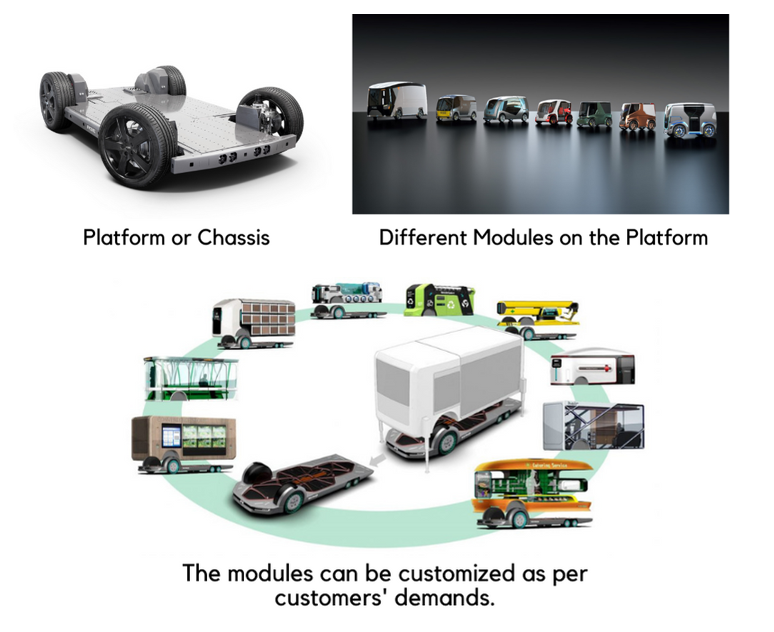The Future of Cars as We Know it
As the effects of the Coronavirus are subsiding, we're able to move around more freely again. New breakthrough technologies are transforming transportation around the globe and transforming how we travel. The automotive industry has witnessed the most notable transformation in the past years.
The "platforms" used by automakers today are engineering tools that help create the vehicle's basic design. The underpinnings of a vehicle are its chassis, drive train, steering, and suspension. To achieve this architecture, automotive companies conform to Platform Sharing which means that two cars can use the same frame, but with differently-styled bodies attached.
Nowadays, the platform is manufactured by a different company and the modules that are integrated on the top of the chassis are manufactured by a different company. Which broadens the aspects of customizing the modules according to the customers' demands.
_22-16-22-12.png)

These are the three platforms or chassis on which cars are build and modified.
Body-on-Frame Platforms:
The frame or the chassis is basically the spine of the vehicle on which the body of the car rests. Body of the car refers to the engine, brakes, steering, wheels and their suspension. It is most popular for trucks The most common vehicle that uses body-on-frame platforms are trucks, SUVs. BMWi3 , BMWi8 use body-on-frame platforms.
Advantages
- They offer better off-road capability because of their higher ground clearance.
- Modifications are easier and simpler to redesign.
- The same frame can be used multiple times, by just modifying the body attached. This results in less manufacturing costs.
- If the frame isn't severely damaged, body-on-frame vehicles may be easier and cheaper to fix after an accident.
- Such vehicles can withstand and resist torsion due to their rigid structure and robust framework.
Disadvantages
- The automobiles tend to be very heavy which results in poor performance.
- Fuel consumption is higher in the vehicles.
- The on-road performance of these vehicles will be compromised due to their high centres of gravity..
- It is possible to compromise handling and traction by torsional flexing during cornering.
Unibody Platforms:
A unitized body is a body that is welded, bonded, moulded, or otherwise joined into a single structural member, including the body, floorboards, and major structural support and crash-protection components. To improve structural rigidity and reduce weight, manufacturers generally integrate the chassis structure with the body. A number of generalized hardpoints get shared, including the centreline of the front wheel, cowl and hip points as well as the location of the drive wheels and the powertrain. A good example of this type of standardized platform is Toyota New Global Architecture (TNGA) with its many variations.
Advantages
- Unibody vehicles are costs less to build, cheaper to buy and has better fuel economy.
- In case of an accident, such vehicles keep you safer as they are flexible.
- They are lighter as compared to the on-body-frame platforms because they are not made of heavy steel frame.
Disadvantages
- Unibody automobiles are expensive to repair when damaged.
- Takes more time to repair them.
- It is expensive to develop and research on them.
Modular Platforms:
Platform architectures are designed to support the installation of a variety of propulsion system modules. It includes the design and assembly of all subsystems of an automobile in an integrated manner, the standardization of design and production of auto parts as modules, and then the assembly of the car according to the positioning of the models. In addition to pure combustion and fully electric XC40s, Volvo also offers their Compact Modular Architecture (CMA).
Advantages
- As the platform can be shared between different vehicles it saves the manufacturer's time and money when creating new ones.
- The modular platforms are also called "flexible platforms" as their dimensions can be changed, be it broad or slim, extended or short according to the need.
Disadvantages
- The designing of the modular platform is challenging as the engineers want to cover as many designs as possible with a single platform, which is difficult to achieve.
- The next challenge is to make each vehicle unique and not merely duplicates of each other. A vehicle's ride quality, suspension, weight distribution and steering feel all need to be adjusted for each of these factors.
References
- Image Credits: https://www.motorauthority.com/news/1128256_new-ev-platform-moves-motors-suspension-and-steering-into-the-wheel-arches
- https://www.technicalripon.com/cars/israeli-startup-with-modular-ev-platform-goes-public-via-spac-deal-expands-to-us/
- https://www.israelhayom.com/2021/04/28/israels-ree-automotive-toyota-subsidiary-hino-motors-ink-business-deal/

